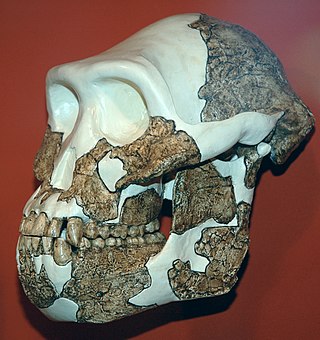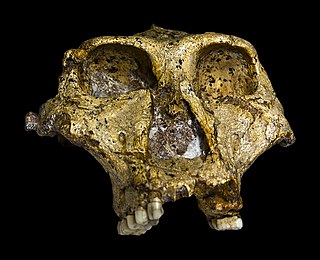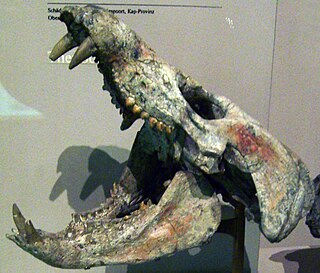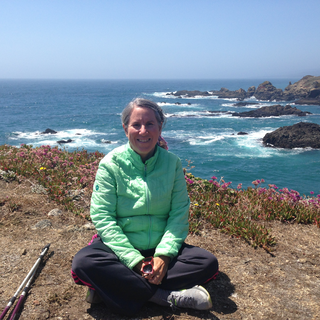Related Research Articles

Paranthropus is a genus of extinct hominin which contains two widely accepted species: P. robustus and P. boisei. However, the validity of Paranthropus is contested, and it is sometimes considered to be synonymous with Australopithecus. They are also referred to as the robust australopithecines. They lived between approximately 2.9 and 1.2 million years ago (mya) from the end of the Pliocene to the Middle Pleistocene.

Isotope analysis is the identification of isotopic signature, abundance of certain stable isotopes of chemical elements within organic and inorganic compounds. Isotopic analysis can be used to understand the flow of energy through a food web, to reconstruct past environmental and climatic conditions, to investigate human and animal diets, for food authentification, and a variety of other physical, geological, palaeontological and chemical processes. Stable isotope ratios are measured using mass spectrometry, which separates the different isotopes of an element on the basis of their mass-to-charge ratio.

Australopithecus africanus is an extinct species of australopithecine which lived between about 3.3 and 2.1 million years ago in the Late Pliocene to Early Pleistocene of South Africa. The species has been recovered from Taung, Sterkfontein, Makapansgat, and Gladysvale. The first specimen, the Taung child, was described by anatomist Raymond Dart in 1924, and was the first early hominin found. However, its closer relations to humans than to other apes would not become widely accepted until the middle of the century because most had believed humans evolved outside of Africa. It is unclear how A. africanus relates to other hominins, being variously placed as ancestral to Homo and Paranthropus, to just Paranthropus, or to just P. robustus. The specimen "Little Foot" is the most completely preserved early hominin, with 90% of the skeleton intact, and the oldest South African australopith. However, it is controversially suggested that it and similar specimens be split off into "A. prometheus".

Australopithecus anamensis is a hominin species that lived approximately between 4.2 and 3.8 million years ago and is the oldest known Australopithecus species, living during the Plio-Pleistocene era.
Bioarchaeology in Europe describes the study of biological remains from archaeological sites. In the United States it is the scientific study of human remains from archaeological sites.

Swartkrans is a fossil-bearing cave designated as a South African National Heritage Site, located about 32 km (20 mi) from Johannesburg. It is located in the Cradle of Humankind World Heritage Site and is notable for being extremely rich in archaeological material, particularly hominin remains. Fossils discovered in the limestone of Swartkrans include Homo ergaster, Paranthropus and Homo habilis. The oldest deposits present at the site are believed to be between 1.9 and 2.1 million years old.
Makapansgat is an archaeological location within the Makapansgat and Zwartkrans Valleys, northeast of Mokopane in Limpopo province, South Africa. It is an important palaeontological site, with the local limeworks containing Australopithecus-bearing deposits dating to between 3.0 and 2.6 million years BP. The whole Makapan Valley has been declared a South African Heritage Site. Makapansgat belongs to the Cradle of Humankind.

Dinopithecus is an extinct genus of very large primates closely related to the baboon, that lived during the Pliocene and Pleistocene epochs in South Africa and Ethiopia. It was named by British paleontologist Robert Broom in 1937. The only species currently recognized is Dinopithecus ingens, as D. quadratirostris has been reassigned to the genus Soromandrillus. It is known from several infilled cave sites in South Africa, all of early Pleistocene age, including Skurweberg, Swartkrans, and Sterkfontein.
Norman Hammond is a British archaeologist, academic and Mesoamericanist scholar, noted for his publications and research on the pre-Columbian Maya civilization.

Diademodon is an extinct genus of cynodonts. It was about 2 metres (6.6 ft) long.
Thure E. Cerling is a Distinguished Professor of Geology and Geophysics and a Distinguished Professor of Biology at the University of Utah. Cerling is a leading expert in the evolution of modern landscapes including modern mammals and their associated grassland ecologies and stable isotope analyses of the atmosphere. Cerling lives in Salt Lake City, Utah.

The term stable isotope has a meaning similar to stable nuclide, but is preferably used when speaking of nuclides of a specific element. Hence, the plural form stable isotopes usually refers to isotopes of the same element. The relative abundance of such stable isotopes can be measured experimentally, yielding an isotope ratio that can be used as a research tool. Theoretically, such stable isotopes could include the radiogenic daughter products of radioactive decay, used in radiometric dating. However, the expression stable-isotope ratio is preferably used to refer to isotopes whose relative abundances are affected by isotope fractionation in nature. This field is termed stable isotope geochemistry.

Anna Katherine "Kay" Behrensmeyer is an American taphonomist and paleoecologist. She is a pioneer in the study of the fossil records of terrestrial ecosystems and engages in geological and paleontological field research into the ecological context of human evolution in East Africa. She is Curator of Vertebrate Paleontology in the Department of Paleobiology at the Smithsonian Institution's National Museum of Natural History (NMNH). At the museum, she is co-director of the Evolution of Terrestrial Ecosystems program and an associate of the Human Origins Program.
Judith Sealy is a Professor and South Africa Research Chairs Initiative Research Chair in Archaeology and Paleoenvironmental Studies and director of the Stable Light Isotope Lab in the Department of Archaeology at the University of Cape Town.

Marilyn L. Fogel was an American geo-ecologist and Professor of Geo-ecology at UC Riverside in Riverside, California. She is known for her research using stable isotope mass spectrometry to study a variety of subjects including ancient climates, biogeochemical cycles, animal behavior, ecology, and astrobiology. Fogel served in many leadership roles, including Program Director at the National Science Foundation in geobiology and low-temperature geochemistry.
Janet Montgomery is a British archaeological scientist and academic. Having studied at the University of Bradford, she is now Professor of Bioarchaeology at Durham University. She specialises in the study of diet and migration via tooth enamel biomineralization and isotope analysis.
Margaret J. Schoeninger is an American anthropologist. She is Professor Emerita of Anthropology at The University of California San Diego, and until recently she was a Co-Director for the Center for Academic Research and Training in Anthropology, or CARTA. Her research is primarily focused on the evolution of the human diet and what this information can tell us about other aspects of human evolution.
Tamsin O'Connell is an archaeological scientist based at the University of Cambridge. Her work has pioneered the use of isotope analysis in archaeology, specifically diet and climate in human and animal tissues.
Michael Phillip Richards is an archaeological scientist, researcher and an academic. He is an archaeology Professor at Simon Fraser University and Tier 1 Canada Research Chair in Archaeological Science, a Fellow of the Society of Antiquaries (London) and a Fellow of the Royal Society of Canada. Richards has published more than 300 research articles. His research focuses on studying the diets diet evolution and migrations of past humans and animals using various techniques such as isotope analysis and radiocarbon dating. His work is highly cited and has gathered media coverage.
Isotope analysis has many applications in archaeology, from dating sites and artefacts, determination of past diets and migration patterns and for environmental reconstruction.
References
- ↑ "Professor Julia Lee-Thorp". St Cross College. 6 August 2012. Retrieved 27 October 2018.
- ↑ "Professor Julia Lee-Thorp | The British Academy". The British Academy. Retrieved 27 October 2018.
- 1 2 3 4 5 "Lee-Thorp, Prof. Julia Anne". Who's Who 2018 . Oxford University Press. 1 December 2017. doi:10.1093/ww/9780199540884.013.U267093. ISBN 978-0-19-954088-4.
- 1 2 "Professor Julia Lee-Thorp". St Cross College. University of Oxford. 6 August 2012. Retrieved 8 October 2018.
- ↑ Lee-Thorp, Julia Anne (1989). Stable carbon isotopes in deep time: the diets of fossil fauna and hominids. Open UCT (Doctoral Thesis). University of Cape Town.
- 1 2 3 "Professor Julia Lee-Thorp". The British Academy. Retrieved 8 October 2018.
- ↑ Lee-Thorp, Prof. Julia Anne. Oxford University Press. 1 December 2023. doi:10.1093/ww/9780199540884.013.U267093. ISBN 978-0-19-954088-4 . Retrieved 6 December 2023.
{{cite book}}:|website=ignored (help) - ↑ "Lee-Thorp, Prof. Julia Anne, (born 20 April 1951), Professor of Archaeological Science, 2010–19, now Emeritus, and Head, School of Archaeology, 2016–19, University of Oxford; Fellow, St Cross College, Oxford, now Emerita". Who's Who 2024 . Oxford University Press. 1 December 2023.
- ↑ "Professor Julia Lee Thorp". School of Archaeology. University of Oxford. Retrieved 6 December 2023.
- 1 2 "Prof Julia Lee-Thorp – Palaeodeserts". www.palaeodeserts.com. Retrieved 28 October 2018.
- ↑ "Palaeodeserts - Climate Change and Hominin Evolution in the Arabian Desert". www.palaeodeserts.com. Retrieved 28 October 2018.
- ↑ "AGRICURB - School of Archaeology - University of Oxford". www.arch.ox.ac.uk. Retrieved 28 October 2018.
- ↑ "Eggtimer". sites.google.com. Retrieved 28 October 2018.
- ↑ "Fellows (FRSSAf)". Royal Society of South Africa. December 2017. Archived from the original on 5 September 2018. Retrieved 3 December 2018.